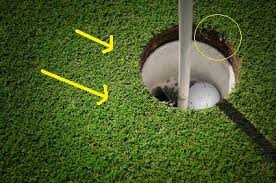I hope you enjoyed watching the WGC – Dell Technologies Match Play as much as I did. Most of the early televised matches were very close so every hole won or lost was critical for each player. There were a number of international players who added to the suspense. I always found myself rooting for one of the players in every match. Typically I found myself rooting for the underdogs and they surprisingly came out on top.
There were 8 playoffs at the end of Round 3 to eliminate a number of players from the 64 player field. In those playoffs 7 of the 8 matches were won by the underdogs. The #3 seed, Jon Rahm, was the only low seeded player to win his playoff.
One of the most exciting matches was between Bryson DeChambeau (#5- the giant killer) who was booming every drive against one of the smallest players in the field, an Englishman, Tommy Fleetwood (#22). Tommy was leading the match by 1 over Bryson going into the 18th hole. Both shot long tees shots (328 and 338 yards) but both landed in trouble in the rough.
Tommy landed his tee shot on a patch of grass in a creek where he had an impossible stretched-out stance with low hanging branches leaving a gap between himself and the hole (at least 20 feet above his location). He had a clear 69 yard shot to the hole but he realized that a low shot up hill would either hit the low hanging branches or never stop as it passed over the green. Adding to the pressure, Bryson had a clear up hill shot to the hole. Losing the hole to Bryson would result in a playoff.
Tommy Took his Medicine
Tommy realized that he had 3 more shots to tie the hole and win the match only if Bryson played a poor chip and then missed his birdie putt. Tommy “took his medicine” to miss the low hanging branches and pitched 91 yards to the rough on the other side of the green but away from the tree. He landed his chip about 8 feet from the hole and sank his par putt after Bryson missed his own 8 foot birdie putt.

It was fun to watch Tommy make his decision to take the shot which was the lesser of 2 evils. The shot was very difficult but he could not afford to take an unplayable penalty shot or he would have lost that hole and possibly the match.
A Great Lesson for All of Us
Don’t take the hero shot especially when the odds are stacked against you. Depend on the shot that will give you the best chance to recover. I don’t think that many recreational players could have made all 3 shots that Tommy had to make to win the hole but it was a great lesson for all of us. Golf is a game where dumb shots don’t payoff. If you hit into a bad location it is far better to take your medicine and waste a shot by hitting to an easy recovery location than it is to end up with a high score on any hole.
Learn to take your medicine and control every shot by practicing with GOLFSTR+. Buy one today at www.GOLFSTR.com
Golf Truism #53: It’s amazing how a golfer who never helps out around the house will replace his divots, repair his ball marks and rake his sand traps.





